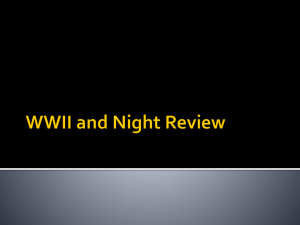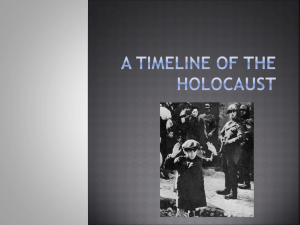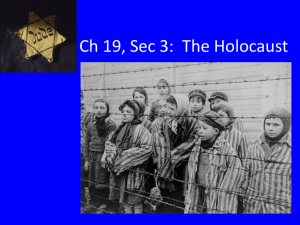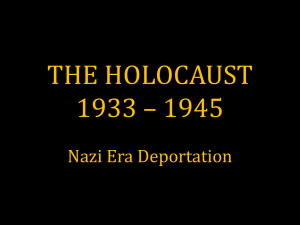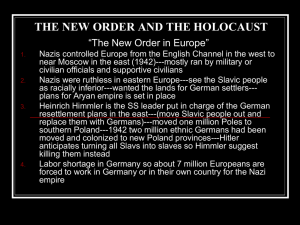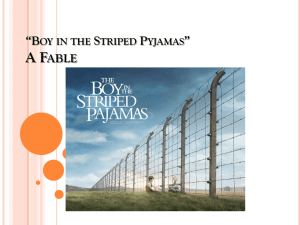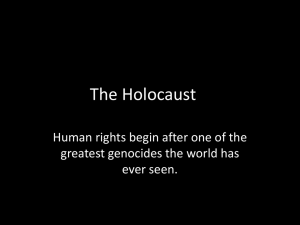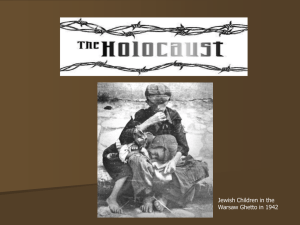A Brief History of the Holocaust
advertisement
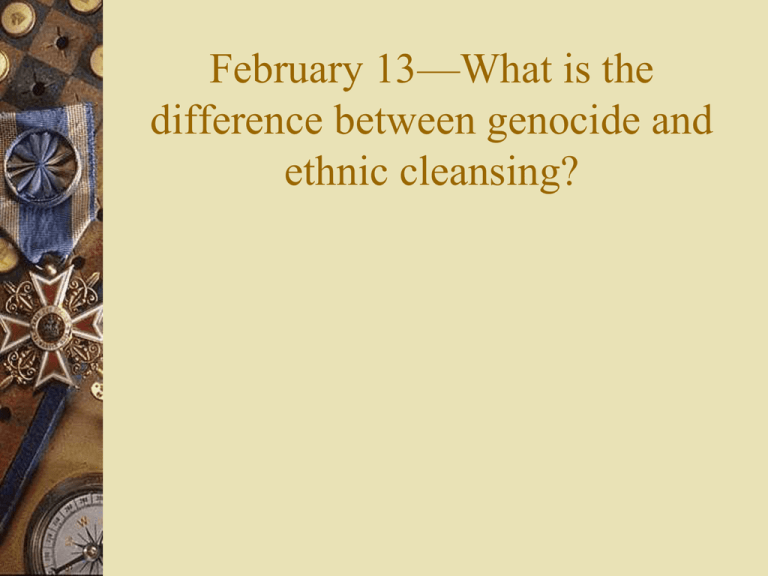
February 13—What is the difference between genocide and ethnic cleansing? A Brief History of the Holocaust Key Terms Genocide Holocaust SS General Reinhard Heydrich “Final Solution” Nuremberg Laws Roma Auschwitz-Birkenau Lecture Outline I. Holocaust A. Definitions B. An Overview II. Summary of the Holocaust A. 1933-1939 B. 1939-1945 C.Aftermath of the Holocaust Quotes “What luck for the rulers that men do not think.”—Adolf Hitler First They Came for the Jews First they came for the Jews and I did not speak out because I was not a Jew. Then they came for the Communists and I did not speak out because I was not a Communist. Then they came for the trade unionists and I did not speak out because I was not a trade unionist. Then they came for me and there was no one left to speak out for me. Definitions What is genocide? Definitions What is genocide? - Genocide is the systematic and planned extermination of an entire national, racial, or ethnic group. Definitions What is the Holocaust? Definitions What is the Holocaust? – The Holocaust is the state-sponsored systematic persecution and annihilation of European Jewry by Nazi Germany and its collaborators between 1933 and 1945. An Overview On January 20, 1942 fifteen high ranking Nazi Party and German government leaders met at Wannsee district of Berlin to coordinate the carrying out of the “final solution.” The leader of the meeting was SS Lieutenant Reinhard Heydrich. An Overview The “Final Solution” was the Nazi regime’s code name for the deliberate, planned mass murder of all European Jews. An Overview Six weeks before the Wannsee meeting, the Nazis began to murder Jews at Chelmno, an agricultural estate located in a part of Poland annexed to Germany. An Overview During 1942, trainloads of Jewish men, women, and children were transported from countries all over Europe to the six major killing centers in German-occupied Poland. Summary of the Holocaust 1933-1939 525,000 Jews, less than 1% of the population, lived in Germany. In 1933 new German laws forced Jews out of civil service jobs, university and law positions, and other areas of public service. In April 1933, a boycott of Jewish business was instituted. February 16—Do you think the Holocaust was inevitable or do you think it could have been prevented? Why? 1933-1939 In 1935, laws proclaimed at Nuremberg made Jew’s second-class citizens. These Nuremberg laws defined Jews, not by their religion or by how they wanted to be identified, but by the religious affiliation of their grandparents. 1933-1939 Between 1932 and 1939, anti-Jewish regulations segregated Jews further. Between 1933 and 1939, about half the German-Jewish population and more than two-thirds of Austrian Jews fled Nazi persecution. 1939-1945 On September 1, 1939, Germany invaded Poland and WWII began. Within weeks the Polish army was defeated and the Nazis began their campaign to destroy Polish culture and enslave the Polish people whom they viewed as “subhuman.” 1939-1945 As the war began in 1939, Hitler initiated an order to kill institutionalized, handicapped, and patients deemed “incurable.” 1939-1945 In the months following Germany’s invasion of the Soviet Union, Jews, political leaders, Communists, and many Roma (Gypsies) were killed in mass shootings. 1939-1945 During the war, ghettos, transit camps, and forced labor camps, in addition to the concentration camps, were created by the Germans to imprison Jews, Roma, and other victims. Statistics There were 10,005 “camps” 941 were forced labor camps 230 were especially made for Hungarian Jews 399 Ghettos in Poland 52 main concentration camps with 1,202 satellite camps 1939-1945 Between 1942 and 1945, the Germans moved to eliminate the ghettos in occupied Poland and elsewhere. They deported ghetto residents to “extermination camps”—killing centers equipped with gassing facilities. 1939-1945 Auschwitz-Birkenau, which also served as a concentration camp, became the killing center were the largest numbers of European Jews and Roma were killed. The killing centers were operated by the SS. 1939-1945 There were instances of organized resistance in almost every concentration camp and ghetto. An estimated 20,000 to 30,000 Jews fought bravely as partisans in resistance groups. Organized armed resistance was the most direct form of opposition. Resistance Armed Jewish resistance took place in 5 major ghettos, 45 small ghettos, 5 major concentration camps and extermination camps, and 18 forced labor camps. Obstacles to Resistance Superior armed power of the Germans German tactic of “collective responsibility” Isolation of Jews and lack of weapons Secrecy and deception of deportations 1939-1945 By the summer of 1944, the Nazis had emptied all ghettos in eastern Europe and killed most of their former inhabitants. After the war turned against Germany and the Allied armies approached German soil in late 1944, the SS decided to evacuate outlying concentration camps. 1939-1945 In May 1945, Nazi Germany collapsed, the SS guards fled, and the camps ceased to exist. Aftermath of the Holocaust Following the war, the trials of “major” war criminals was held at the palace of Justice in Nuremberg, Germany between November 1945 and August 1946. These trials were conducted by the International Military Tribunal. Aftermath of the Holocaust Trials and investigations continue today.


